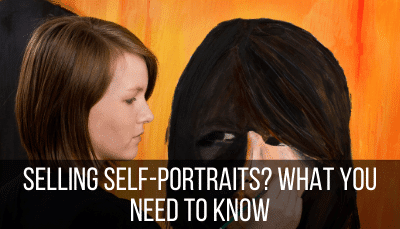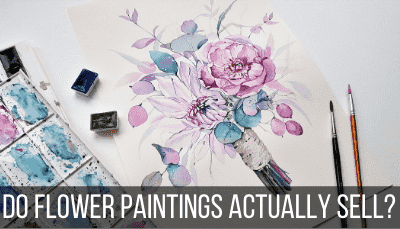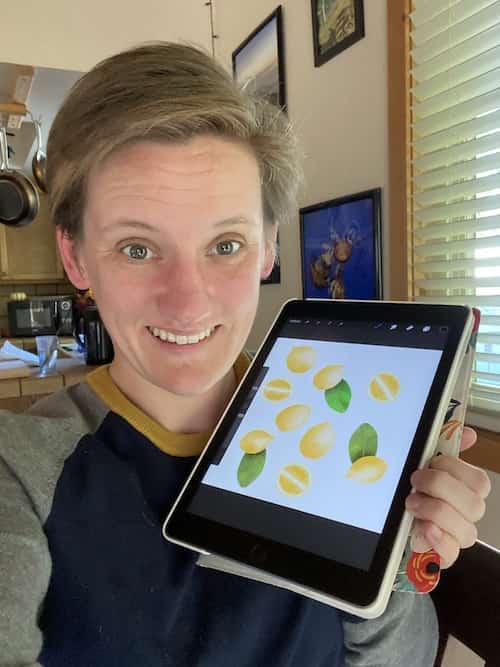When You Sell Canvas Art Do You Sell the Original or Make Prints
This mail service may contain chapter links
When y'all're getting started with selling art, all of the choices tin can be overwhelming. Where do you sell? How do yous sell? What can you sell? Ane of the well-nigh fundamental questions that you need to answer first is: volition you lot exist selling original art, or prints? This is a really of import question and, if y'all need to answer it from the become-become in gild to even post your beginning listing.
Selling original art is great if you are targeting art collectors, investors, museums, or galleries. Fine art prints make sense if yous plan to sell your art to a large audience, in mass. Prints are well suited for online platforms like Etsy, or in person venues like farmer's markets or craft fairs.
Deciding whether you should be selling original fine art vs. prints tin shape the direction of your art selling career. Information technology volition fundamentally change your audience, production strategy and overall focus. That's not to say you can't practice both, which we'll talk about at the cease of this post. To begin with though, let'southward talk about the details of selling original art vs. prints so that y'all tin fully understand the benefits and ramifications of both.
Selling Original Art
When you lot sell original art, you create one slice of artwork that is sold once. For most artists, this means that no copies are made of that piece of artwork. The purchaser is the just one who owns any version of that piece of art. It'southward an original.
When you sell original art, it has a higher value than a impress. It's unique and buyers will pay more than for the exclusivity of being the only one to own that slice of work.
This makes sense when you recall virtually the audition that typically buys original fine art. Art collectors, galleries, and museums pride themselves on having unique art collections that tin can either be resold, or capeesh in value overtime.
If thousands of copies of the fine art be, it normally isn't every bit interesting or valuable. Which leads us to our side by side point.
To sympathize it in a different way, let's put ourselves in the shoes of the buyers of original art for a 2d.
Why you lot should purchase original art?
Given that it'due south i of a kind, original art has a college value than fine art that is created in large quantities every bit prints. Art galleries purchase original art in society to resell it. Fine art collectors hope that original fine art increases in value and can be treated equally an investment.
Let'southward say that yous own an art gallery. You purchase original fine art with a focus on reselling it. The beginning priority is that you recoup your costs from purchasing and marketing each slice of artwork. The 2d priority, ideally, is that you make a profit.
Buying originals, y'all know that your customers won't observe the same work anywhere else. This allows you lot to price it higher and gives your customers an incentive to buy from you. I hateful, they won't discover that art anywhere else!
Let's say that y'all source art for a museum. You know that your attendees expect to see art and collectibles that they have never seen earlier and volition never see anywhere else. Why would they go to a museum otherwise? Finding an original fine art that fits within a certain exhibit is like finding a needle in a haystack, which increases its value and cost.
Let'south say y'all're an art collector. You pride yourself on the unique drove of art that you lot own and y'all likewise see information technology as a monetary investment. Y'all hope that the art will appreciate overtime and contribute substantially to your net worth.
At present that we empathize the major players who typically purchase original art, nosotros demand to talk about the caution you need to have near selling prints along with your originals.

Why you need to be conscientious about selling prints when you sell original art
For everyday artists, the value comes with selling a i-of-a- kind piece of work that no ane else has.
When artists get extremely famous, that tin modify. It'southward common for prints to exist sold in addition to the originals. The creative person is so incredibly famous and the originals are worth so incredibly much that owning an original is a bespeak of high status, regardless of whether prints of that work be.
If that'due south confusing, let'southward await at an example.
In 2010, one of Pablo Picasso'south original works became the most expensive pieces of art ever sold at sale (source). Nude, Green Leaves and Bust sold for a mindblowing $106, 482, 500 (source). Yet, yous tin can purchase a print of this work for less than $30.
Nude, Greenish Leaves and Bust, 1932, Pablo Picasso picture.twitter.com/GUMAISxdhv— Olga Tuleninova 🦋 (@olgatuleninova) July 26, 2020
As far as Picasso is concerned, there'due south a HUGE cost difference between his original works and his prints. If the owner of the $106,482,500 version and the $30 version stood next to each other, there would be no dubiousness that the 1 who shelled out many millions of dollars had the more than valuable version. Information technology's monetary value is 3,549,416 times that of the prints.
But, whether we like it or not, many of united states aren't Picasso and never will be. Let's say that you sell an original for $iv,000. Before you sold it, you made some prints and sold them for $thirty. In this case, your original is just worth 133 times that of the prints.
Depending on who you sell the original to, the fact that prints exist could devalue the original enough to make it an unappealing buy.
Hither'south some other example. There's a gallery in Lake Tahoe that features the work of Dr. Seuss. I could head to the children's section of the library and pick up a ratty re-create of a Dr. Seuss book and run into the aforementioned matter. Only, the feel isn't the same at all.
No, what'southward neat about the gallery is that you see limited editions and originals. It's a whole other world.
We'll talk about this more in the last section near selling both prints and originals.
Your Focus as an Artist When Selling Originals
When you sell original piece of work to galleries and museums, yous want to make sure to do a lot of inquiry. You but get to sell each slice of work one time, and then y'all better practise your due diligence to make your artistic efforts worth it.
Sometimes, this doesn't mean getting the right cost. If the Metropolitan Museum of Art wants to feature my work, heck I'll pay THEM to put my artwork in the downstairs bathroom, let alone sell information technology to them to be featured in a main exhibit.
You need to understand where you lot are in your art journey. Are you even so establishing yourself and willing to sacrifice a few dollars for more than exposure? Are you an established artist with a strong reputation who now is more selective and looking for the highest price?
Make up one's mind what you're looking for. This will make your selling experience MUCH easier.
Once you understand what you want equally an artist selling original work, it'due south time to identify WHO and WHERE you want to sell to. Browse through some galleries and museums while keeping the following in mind.
1. Have they taken piece of work like mine before?
If you create portrait photography, y'all might non have a lot of luck selling to galleries or museums that primarily focus on acrylic landscapes. If your art is edgy and modern, you might not have luck selling to galleries or museums that focus on archetype and historical work.
Find the correct fit for your art, stylistically.
2. Understand the rules and procedures
All galleries and museums have rules and procedures around how they curate and purchase artwork. Following these rules is non merely important for making sure that your artwork makes it through the first screening process, but it can too verify that your art is a good fit.
Let's look at the rules for the Oakland Museum of California. Even a quick glance volition tell y'all that they prefer artwork and/or artists that have a connection form California. If you're an East Coast artist promoting a painting of NYC, yous might be out of luck. The rules likewise conspicuously lay out the information y'all demand to include when contacting the museum nearly your piece of work. If you don't include this info, information technology's unlikely you'll be noticed (source).
Understand what the gallery, museum, or art collector wants, expects, and needs from an fine art buy. This will give you lot a huge leg up when approaching them and could be the difference between making a sale and not making a auction.
If y'all're interested in selling your art to museums or galleries, I have an in depth mail service about how to practice only that. Be sure to check out: How to Sell Your Art to Museums and Galleries

Selling Prints
When you sell prints of your art, you open yourself up to a wider audition of buyers. You also need to price your art lower. For prints, selling each copy for many thousands of dollars isn't going to work. If you sell a lot of prints though, this can add upward to equally much, or more, than an original.
To understand it in a different way, let's put ourselves in the shoes of the buyers of original art for a second.
Why you should buy prints of fine art?
If you're like me, you enjoy art, just you aren't a curator for a gallery or a museum. You lot also aren't rolling in millions of actress dollars, which ways you aren't an art collector, or you only dabble in it with lower priced art.
Instead, you buy fine art that you enjoy and tin afford. Usually, this means you lot buy prints.

Maybe you moved into a new apartment and have actress wall space. Y'all browse Amazon to meet which art appeals to you, is within your budget, and comes with free shipping.
Peradventure you're at a farmer'southward market or craft fair and there'south a booth that catches your eye. Y'all kickoff chatting with the artist and actually jive with their personality and way. You want to support them and concede that there'southward a print in your living room that could do with some refreshment. You pick out a dainty print and replace the dried one in your living room.
Here are the huge differences betwixt buyers of original art and the buyers of prints summed up:
Originals: investment-focused with an eye for hereafter profit
Prints: upkeep-focused with an middle for maximum enjoyment
Ok, now that nosotros've understood the buyers of prints, let's talk about what it ways for yous every bit a seller.
Are fine art prints worth anything?
When you sell prints, it's unlikely that they'll be worth anything beyond that first auction. They are meant to be sold in mass, appreciated by the buyer, but non resold again. This is dissimilar from original pieces of art that appreciate in value overtime.
There's an exception hither though: limited edition prints
Limited edition prints are prints that are produced in a modest quantity. This increases their value because, given they aren't mass produced, at that place are but a few copies to become around. Limited edition prints can be sold for a few hundred to a few thousand dollars depending on the fame of the artist and the number of prints that are fabricated.
Unlike typical prints that are produced in unlimited quantities, express edition prints can be resold given that they go more than and more rare equally time goes on.

Your Focus every bit an Artist When Selling Prints
A LOT of artists sell prints and a LOT of artists make a LOT of money selling prints. The cardinal words here are, "a lot." Apparently, y'all'll make more money selling an original piece of art for $iv,000 than a print for $30.
But, what if you sell that $thirty print once again and again and again? Information technology won't have long before your turn a profit is above the $iv,000 yous would have fabricated from selling it as an original. When yous sell prints, your profit is potentially unlimited.
When y'all sell prints, yous demand to focus on book.
Build a social media presence, start an Etsy store, go to farmer'south markets and arts and crafts fairs, spread the word to friends and family.
If you're thinking that this all sounds great, but how the heck are you going to deal with printing and packaging SO many prints? Well, I take a solution for you.
I use Printful for my own Etsy store and it has been a key player in turning my online store into a passive, money making automobile. Printful offers a number of products including mugs, shirts, sweatshirts, hats, stickers, and even jewelry. And, yes, they offering prints too!
When a customer makes an order through Etsy, Shopify, or i of the other platforms they integrate with, Printful will automatically process the order and send it to your customer. No piece of work needed from you!
Printful is a great way to get started with selling prints. No risk; no upfront costs; no hassle. But, no matter how you lot determine to sell prints, make sure y'all're focused on selling a LOT of them. Bank check out Printful by clicking here!
Selling Originals Art and Prints at the Same Time
If you've read up until this point, it's pretty clear that selling both prints and originals won't piece of work. Information technology'southward tricky, to be sure. If y'all want to go downwards this road, the offset affair you'll want to do is thoroughly understand the rules of the museums and galleries you're hoping to target.
What are their feelings most originals that accept had prints made of them? What price cutting could you be facing?
It's highly unlikely that you lot could sell an original while besides selling prints at the same time. At the very to the lowest degree, you'd take to discontinue your prints.
Honestly, this is pretty sticky and I wouldn't encourage it.
Just, yous Tin sell originals of some work while selling prints of another. If you have a large drove of art, there'southward no reason why you tin't take some pieces that yous sell prints of and others that are reserved to exist sold as originals. This can requite you the best of both worlds without breaking whatsoever rules or getting into tricky territory.
When you get started with selling your art, in that location's no uncertainty that you'll run into the question of selling originals vs. prints very very quickly. Information technology's likely the first question you'll run into. Every bit long as you practise your research and have a articulate idea of what you want from your art selling career, you'll be in a great place to get started.
If you lot want a leg up in starting your art business, I HIGHLY propose Skillshare. They have a lot of business classes that are geared directly towards artists. Click the imprint or click Hither and you'll get a trial of Skillshare for gratis. It's more than enough time to brush up on your business skills and get your art shop off of the ground.

Diana has been an artist for over 25 years and has preparation in drawing, painting, digital drawing and graphic design. Diana's latest obsession is digitally cartoon with Procreate and creating t-shirt designs with Canva. Diana has experience selling her fine art across a number of platforms and loves helping other artists acquire how to brand money from their art likewise.
Source: https://adventureswithart.com/sell-original-art-or-prints/
Post a Comment for "When You Sell Canvas Art Do You Sell the Original or Make Prints"